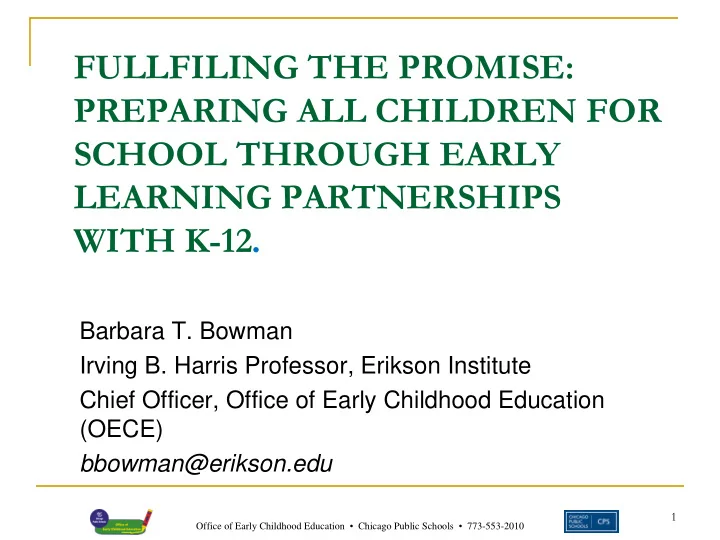

FULLFILING THE PROMISE: PREPARING ALL CHILDREN FOR SCHOOL THROUGH EARLY LEARNING PARTNERSHIPS WITH K-12 . Barbara T. Bowman Irving B. Harris Professor, Erikson Institute Chief Officer, Office of Early Childhood Education (OECE) bbowman@erikson.edu 1 Office of Early Childhood Education • Chicago Public Schools • 773-553-2010
CHICAGO OFFICE OF EARLY CHILDHOOD EDUCATON 2010 40,800 Children and families Budget: $1,920,000 2 Office of Early Childhood Education • Chicago Public Schools • 773-553-2010
RATIONAL FOR INVESTMENT Early experience affects brain development. 0 - 5 programs can change educational and social outcomes. Specific academic and social/emotional skills and knowledge at preschool age predict later school achievement. Economic and social benefits from preschool . 3 Office of Early Childhood Education • Chicago Public Schools • 773-553-2010
THE CHALLENGE 4
In varying periods of time (full day/half day, one year/five years) under various auspices (centers, homes, schools), teachers and caregivers will teach all children (particularly those at risk of school failure), so at the end of the preschool years, children will have the same outcome (kindergarten readiness), allowing them to learn in school (large units grouped by age), the same things (academic subjects and social behavior), with diverse curricula as measured by standardized tests. 5
THE SAME OUTCOMES? 6
It really is rocket science 7
CPS PROGRAMS PRESCHOOL FOR ALL – 32,000 Preschool (schools: 14,000; agencies: 10,000) Prevention Initiative (agencies – infants/toddlers: 3,000) families: 5,000) HEAD START (In schools) – 7,200 TUITION BASED PRESCHOOL – 500 CHILD-PARENT CENTERS – 1,100 8
SCHOOLS (CPS) GET HERE? HOW DID CHICAGO PUBLIC 9
EARLY EDUCATION AND CHILD CARE CAME TOGETHER 1960s Began mending the division between child care and early education (CAEYC) 1966 Head Start cut across organizations and institutions 1970s Joined together to revise licensing standards locally and nationally 1980s Joint committees organized by Mayor and Governors. Today: Early Learning Council 10
RESEARCH DISSEMINATED Westinghouse Intervention Studies HIGH/SCOPE CHILD PARENT CENTERS ABCEDARIAN Brain development Early Intervention Economic benefits 11
PHILANTHROPIC COMMUNITY ENGAGED Long history of preschool education Frances Parker Mental health interventions Institute for Psychoanalysis Institute for Juvenile Research Public/private partnerships Ounce of Prevention Long term funding commitments McCormick Foundation University research 12
PREK in CPS 2010 State 0 -5 Budget 127m 1930s Experimental 1975 Certification Preschool - ended for Prekindergarten 1942 (Special Ed) extended to Prek-3 1965 Summer Head Start in 1986 State Chicago Public Preschool Initiated Schools Infant Prevention 1968 Year-around Initiative Head Start 13
THE ILLINOIS MODEL Agencies and private schools can receive Preschool for All $. State education funding can be combined with Head Start, Child Care, and special ed . Layered model: Child Care Block Grant + Head Start + Preschool for All + Special Education Most at-risk children received most public funding. Set asides for Prevention 0 – 3 . 14
THE CHICAGO MODEL: CPS/FSS WORK TOGETHER Fund each other’s programs (Head Start/PFA). Share services Share data (C-PEP, ECERS, ELLCO, CLASS). Top administrators meet together bimonthly. Work with DCFS for licensing, homeless, foster children, etc. 15
WHY FOCUS ON EDUCATION ? THE ACHIEVEMENT GAP 16
READING ACHIEVEMENT GAPS… Percent Meeting/Exceeding 100% 88% 74% 82% 80% 66% 68% 60% 44% 51% 40% 35% 20% 2003 2004 2005 2006 Asian/Pacific Black Hispanic White 17
MATHEMATICS ACHIEVEMENT GAP…. 94% Percent Meeting/Exceeding 100% 80% 86% 80% 75% 70% 60% 48% 53% 40% 32% 20% 2003 2004 2005 2006 Asian/Pacific Black Hispanic White 18
MYTHS CHILDREN WHO ARE DEVELOPMENTALLY COMPETENT WILL AUTOMATICALLY DO WELL IN SCHOOL ALL CHILDREN CAN LEARN WITH THE SAME CURRICULUM. CHILDREN MUST KNOW THEIR HOME LANGUAGE BEFORE THEY LEARN ANOTHER. 19
WHAT MAKES A DIFFERENCE IN INTERVENTION Structural factors Ratios Group Size Teacher knowledge Content Children’s prior knowledge Interactional variables 20
WHAT DO WE KNOW ABOUT EFFECTIVE PROGRAMS? Content matters Alignment matters Relationships are important Teaching is hard work 21 Office of Early Childhood Education • Chicago Public Schools • 773-553-2010
TOOLS TO MEET THE CHALLENGE Early Learning Standards Program assessment instruments Curricula planning technology Intervention/motivation strategies Parent involvement Professional development 22
ISSUES Either/or ideologies Assessment of children ½ day/full day programs Bilingual education Inclusion Parent involvement 23
WHAT SHOULD TEACHERS DO? Make sure children love them and love learning. Teach the facts, what they mean, and why they are important. Teach thinking; it doesn’t just happen. Children are continuously engaged in learning; children who are interested and busy are less likely to be naughty and whiney . 24
WHAT SHOULD PRINICIPALS & DIRECTORS DO? Address factors leading to better outcomes for children (curriculum, grouping, differentiation) . Align expectations across grades. Assess teaching and learning. Try out new ways to enhance learning. (Nothing changes if nothing changes.) 25 Office of Early Childhood Education • Chicago Public Schools • 773-553-2010
WHAT SHOULD K-12 SYSTEMS DO? Collaborate with childcare and Head Start to set common expectations for K. Require positive parent and community involvement Provide or cooperate in the development of before and after school options. Provide IT assistance to agencies for data management. Set performance standards. 26
WHAT SHOULD ADVOCATES DO? Campaign for improvement -- but recognize reality. Develop a model that is flexible; everyone doesn’t need the same things. Review teacher preparation programs. Make alliances; no one group can have everything. Do your homework; you need levers to change. 27
WHAT I HAVE LEARNED! Change is a messy process: stake holders interests make it harder. All services are important; focus on the children. Families do not always care about the same things professionals want. Neither is right or wrong. Compromise. Get thick skin. Someone will not want what you propose. Everyone can change -- even me. 28
“Education costs money, but then so does ignorance ." -- Sir Claus Moser 29
Recommend
More recommend